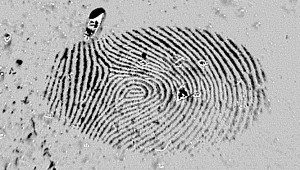
When searching for traces and solving criminal cases, fingerprints on paper are often very important. However, visualizing latent fingerprints on paper requires a special process.
The common method to detect latent fingerprints on paper is ninhydrin-treatment. Applying this treatment, latent prints can be revealed when they are already absorbed into the fibers of the paper or when they are older. The process is based on a reaction of ninhydrin with amino acids in the sweat residues of the latent fingerprint, developing a colorant (Ruhemanns Purpur).
However, washed-out fingerprints are hardly traceable and even less accepted in court.
Nowadays, Israeli researchers develop a method which does not depend on the sweat residues of the fingerprint but on the skin fat left behind. This method utilizes nano-particles. At first, gold-nano-particles are placed on the paper. These particles stick to the paper, not to the latent print. In a second step of the process, silver is spread on the paper. This sticks to the gold and blackens those parts of the paper. The result is a negative picture of the so far invisible fingerprint. The skin fat serves as a masking of the paper surface and thus prevents the gold from attaching.
With this method being based on skin fat that is the left behind, it is applicable even on moist paper. The sweat residues are washed away, while the fat stays.



